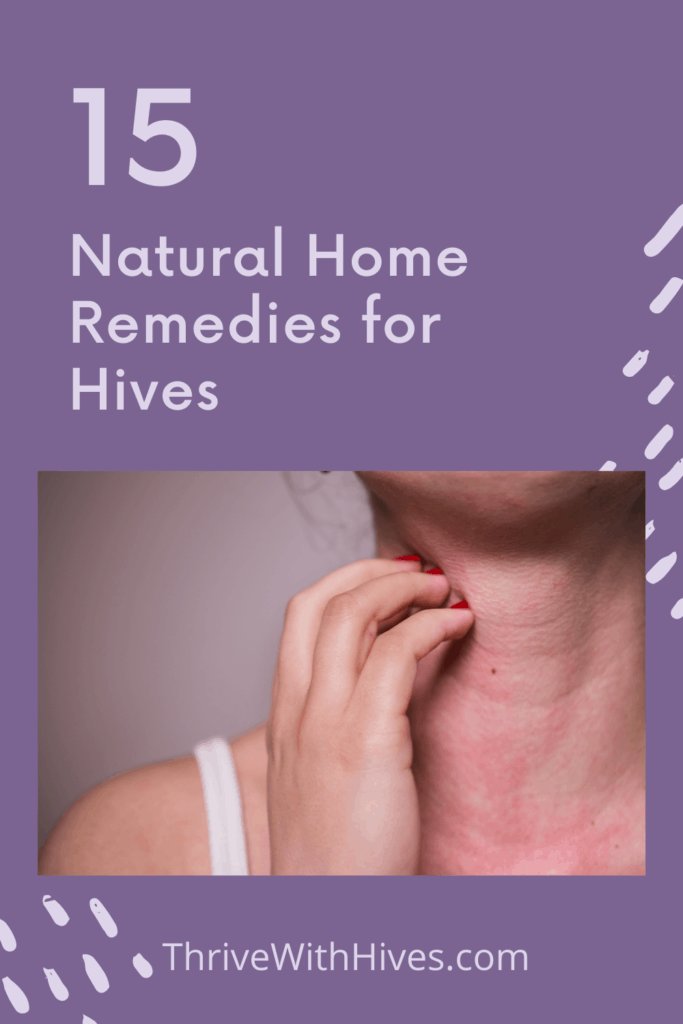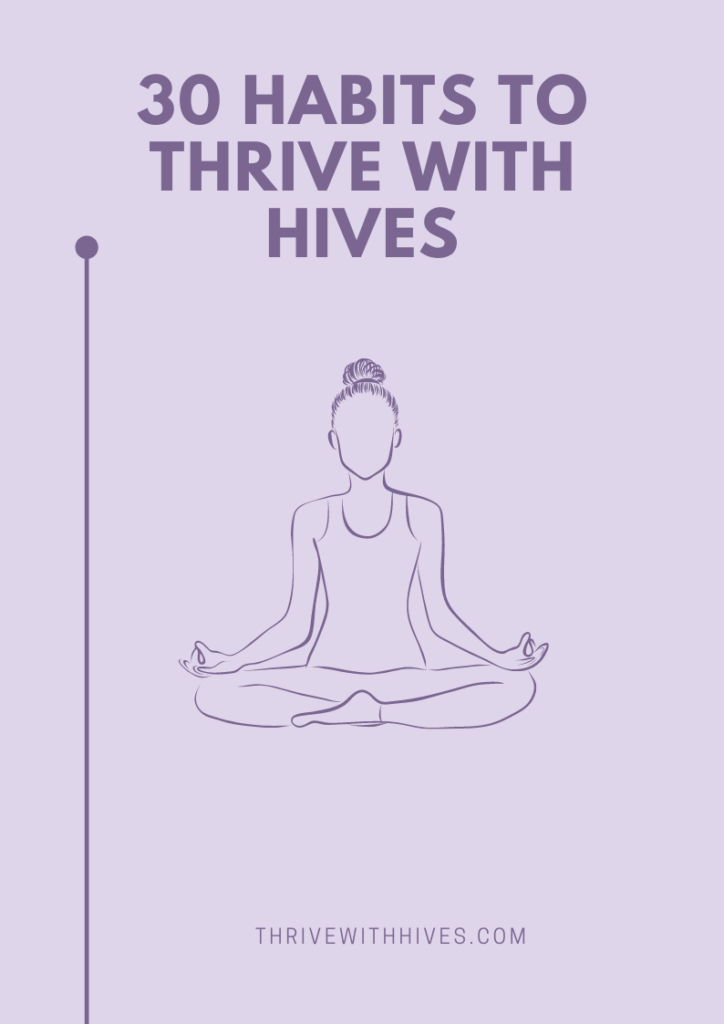15 Natural Home Remedies for Hives
It’s the middle of the night, and you are wide awake again, searching for solutions to this miserable condition. You are suffering from chronic hives and can’t seem to find relief. You can’t sleep, can’t work, or can’t socialize because of the impact of the constant itching and embarrassing appearance. I’ve been there. I was desperate for relief. I found myself crying at times, wondering why God was punishing me. I spent many nights awake and searching endlessly for that evasive cure. I, too, spent many nights googling “natural home remedies for hives”.
I have been dealing with this for ten years now and have found what works for me after much research, trial, and error. You may be on the same path I was, desperately searching for the magic that will cure hives. Unfortunately, there is no magic bullet. The solution isn’t so simple. Chronic Urticaria symptoms can be managed, but it will take work on your part. The key is to find balance in your life and be willing to have an open mind and try different things.
Personally, I try to avoid steroids, even applied topically. Of course, they may be necessary if you are in a severe flare. When I first started having skin issues, topical steroids were a Godsend. But I knew that even topically, it is being absorbed and can have repercussions taken long term. I sought natural remedies for hives and experimented with a few to find what worked for me.
Here I outline 15 natural home remedies for hives. Take it slow, don’t mix a bunch together in a bath (speaking form experience) out of desperation. Try one remedy at a time to be sure you don’t have a negative reaction. You can experiment with mixing them later on.
Remember, before trying any topical, a small patch test on the inner forearm is important. We definitely don’t want to cause your hives to flare more. Everyone reacts differently; what relieves someone else’s hives may make yours a full-blown flare.

I am not a physician; nothing on this blog should be taken as medical advice. This is a general overview of my own research. As always, you should check with your physician before making any changes to your treatment plan.
As an Amazon Associate, I may earn a small percentage from products purchased through links on this site. I appreciate your support and would never link to something I would not use personally.
Here are 15 natural home remedies for hives.
Apple Cider Vinegar
Apple cider vinegar has an anti-inflammatory and anti-histamine effect and has been known to relieve itching and swelling. You can put some in your bath water or mix some in a cup of cool water and apply with a cloth to the affected areas.
Some find it beneficial to drink it as well. Be sure to dilute it before drinking to avoid burning your esophagus. Mix 1-2 tablespoons in a mug of warm water, and add a little honey to make it more palatable. It tastes horrible, honestly, but you get used to it.
Baking Soda
Baking soda can be used in the bath to help relieve itching. Use about 1-2 cups in the bathwater. As with apple cider vinegar, you can use it as a more concentrated paste as well. Just mix some baking soda in a glass or bowl with water and apply topically with a cloth. This one makes me itch more, but I have heard a lot of people say it relieves their hives. As with anything, our results will vary.
Turmeric
I love turmeric. If you have been with me on my journey for a while, you know that turmeric is one of my favorite natural home remedies for hives. It is a great anti-inflammatory and helps relieve pain, reduces swelling, and is known for its positive effects on the skin. Two teaspoons of turmeric mixed in a warm drink are recommended daily to decrease the overall inflammation in your body. I notice a big difference in my pain when I drink turmeric ginger tea daily. If I run out I can definitely feel the difference.
Turmeric is a great NSAID alternative that may help prevent cancer, boost your immune system, and keep your mind sharp. Another great bonus is its anti-aging qualities. Make Turmeric a part of your daily routine to experience these benefits for yourself.
This is the turmeric supplement that I use. It has turmerones that assist the body to absorb the beneficial curcumins better.
Here is the turmeric powder I use. I buy in bulk and store in jars:
Oatmeal
This one is classic. I’m sure we have all heard about the wonderful benefits of an oatmeal bath for our skin. Oatmeal has anti-inflammatory effects and can ease itching and swelling when applied topically in a bath. I like to use an old sock or pantyhose so that it doesn’t leave loose oats in the drain or bottom of the tub. Place about 1 cup of oats in the sock and tie the top. Place under the faucet while running your bath. The bottom of the tub may be slippery, so be careful. You can also take the sock and run it over your skin while in the bath. It also has a moisturizing effect. Added bonus, baths may help reduce your stress, another factor in Chronic Hives.
Mint
Mint is known for its cooling abilities and is also soothing to the skin. It has anti-inflammatory, analgesic (pain-relieving), and antiseptic (kills bacteria) properties as well. Use it as a poultice by boiling some mint leaves and placing them directly on the skin.
Alternatively, I occasionally like to have a cup of mint tea, and I simply use the cooled tea bag on my skin. You can also make a batch of mint tea ahead of time and store it in the refrigerator; apply it with a cloth to the skin for a nice cooling and soothing of your skin during a flare.
I used to keep a spritz bottle of water with a few drops of peppermint essential oil on my desk at work for those hot days. I spray a small amount on exposed skin to keep it cool. Read this for more chronic urticaria workplace tips.
Ginger
Ginger is another one you will hear me talk about repeatedly. There are so many benefits to ginger. As I mentioned earlier, I drink Turmeric Ginger tea daily and supplement as needed. It is another great natural treatment for pain.
Not only does ginger have great anti-inflammatory benefits, but is also a natural anti-histamine. You can drink the tea like mint and turmeric and apply the cooled tea bag directly to the skin. Or boil a piece of ginger root and use the cooled liquid on a cloth to apply directly to the skin as needed.
Alternatively, you can use the essential oil either internally as a supplement or diluted topically.
Nettle
Stinging nettle leaves are another natural anti-inflammatory that is known for its ability to reduce allergies in some people. Nettle leaves are also full of nutrients and antioxidants, making them a great addition to your herbal arsenal.
Like the other teas mentioned, you can get nettle tea and apply the cooled bag to your skin or make a poultice. I don’t care for the taste of nettle tea, but I do drink it occasionally, and I put a mint tea bag with it to help make it more palatable.
Holy Basil
Holy basil is named that for a good reason. Also known as Tulsi, translates to “the incomparable one.” It has an interesting history as a sacred holy herb in Hinduism. This sacred herb has many benefits, including its ability to treat hives.
Holy Basil has anti-oxidants and helps combat the effects of stress. It has been used to treat many skin ailments, including eczema, acne, dandruff, and hives.
Drink it as tea, or use it as a poultice. I like to do both.
Tulsi essential oil cannot be taken internally but makes a great poltice or dilute and applied topically.
Witch Hazel
Did you know that Witch hazel is a natural herbal extract? You can get witch hazel at your local pharmacy, but it comes from a shrub’s leaves. It is rich in tannins which help reduce swelling. Dab some on a cotton ball and apply directly to hives for relief. Or you can add some to your bath.
Epsom salt
Add 1-2 cups of Epsom salt (Magnesium Sulfate) to your bath to help reduce your hives, ease joint pain, and reduce anxiety. It may also help migraine sufferers and is often used in detox protocols. Soak in Epsom salt bath for 15-20 minutes. Drink a glass of water after your bath and try to relax for at least an hour after.
Aloe Vera
This one is a classic. If you think about sunburn, what is the first treatment that comes to mind? Okay, well in my family, it was Noxzema, but most people associate Aloe Vera as the go-to home treatment to relieve the pain of sunburn. This is because Aloe is a great anti-inflammatory.
You can get Aloe in a bottle from the store or, better yet, have an aloe plant in your home and cut off a leaf as needed. You can apply the aloe gel topically to affected areas to feel the relief that this plant can provide.
Use caution when buying at the store, making sure to check the ingredients. I once purchased what I thought was simply Aloe because that’s what the bottle said, but when applied, it made my skin burn. Checking the ingredients, it was full of other additives, including fragrance (please avoid this ingredient). You want pure Aloe.
There are also benefits to taking aloe internally. You can buy aloe juice to help heal your gut. Poor gut health is often associated with skin conditions like hives.
Tea Tree Oil
This essential oil can be used to treat acne, ease eczema and relieve hives. A known anti-inflammatory and antiseptic, this is one of the most popular essential oils.
Tea tree essential oil can be applied topically to the skin. As always, patch test a small area on your inner forearm before using it on larger areas. You can dilute it in a carrier oil like coconut oil, which also has benefits for your skin.
Coconut oil
Not only is coconut oil tasty, but it’s also moisturizing and soothing to the skin. This one you can use as a carrier oil to try some of the beneficial essential oils on this list. I apply directly to the skin straight after a shower to lock in moisture. Avoid using it on your face, as it may block pores.
Cold Compress
Another classic, as you would apply a cold pack to an injury to prevent swelling, you can apply a cool compress to ease the inflammation of your hives or angioedema. This is another one of those that may also cause hives in some. I don’t tolerate cold well, personally, and when I use “cool” on myself, it’s room temperature. Others find relief using ice packs. We are all different.
Green Tea
I’m sure you have heard about all the wonderful benefits of green tea, from cancer prevention to anti-aging to improving brain function. Not only is it a great anti-inflammatory, but it has antihistamine properties as well, making it a great option for relieving hives.
Drink green tea in place of your morning cup of coffee and apply the cooled tea bags topically as needed. I like this one specifically for angioedema around my eyes. Just be sure it’s not dripping; it should be damp but not wet if applied near the eyes.
Experience Some Relief
I hope that you found this list beneficial and get some relief from your hives. Most of these can be mixed together once you know that you can tolerate them. Throw some essential oils into your bath or mix your teas, poultices, etc. I also like to mix things up sometimes, but ginger turmeric tea is a daily ritual for me.
Have you tried any natural home remedies for hives? Share in the comments.
Want to learn more about Chronic hives? Check out my post on Chronic Urticaria FAQ.

For Thrive with Hives updates, subscribe to the newsletter HERE and get your free guide on 30 ways to Thrive with Hives.



Thanks so much. You mentioned turmeric with black pepper . I read that black pepper is very high in histamines.
Hi Sylvia. Black pepper may be a trigger for some who are very sensitive to high histamine foods. Unfortunately with chronic urticaria there is no one size fits all when it comes to diet. If you react to black pepper than you may want to try one of the alternatives listed.